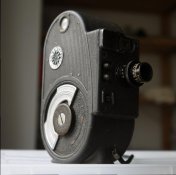Certainly NOT! That is a Bell & Howell and all that I have seen were never covered with leather either 16mm, which I think yours, is or 8mm. That would not be restoring, rather it would be ruining the looks of it as it came from the factory.
Funny, I know that it’s a Bell & Howell, I can tell you exactly which model: Bell & Howell Filmo 8 134-E. Model E has the rear bearings removable but without oil bores. I also know that they were all sold like this, I only thought it could be an interesting idea to cover those screw feet the first time. Has nobody ever wondered about them? Bell & Howell Co. seems to still have a nimbus to them, that’s interesting, too. An early company to install extensive outsourcing, one must know that the little company wasn’t able to manufacture the famous perforator in 1908. It was simply bought. Bell & Howell couldn’t do the casting of the 1910 printer, neither of the main parts of the 2709 camera, nor of the 1918 pedestal splicer. The list is long and B. & H. depended still more on third parties with everything optical. Many parts, if not all, were made by others.
The story of the first wooden housing cameras destroyed by mildew and termites in Africa is a debunked myth. The motive for producing an all-metal camera is quite different. But I’m drifting off.
I have repaired and restored a number of Filmo 8s. Of course do I leave them the way they are. The outer appearance isn’t that important anyway. The valuable things are deep inside. By the way, B. & H. had offered a renovation of cameras back in 1942. That cost $7.50, $112.15 as of today, and consisted of extraction of the works, a fresh lacquering of the main frame, and reassembly. Filmo 8s were available in black and dark brown until December 1953 when fawn metallic and dubonnet was introduced.




